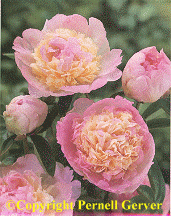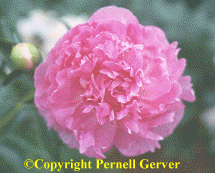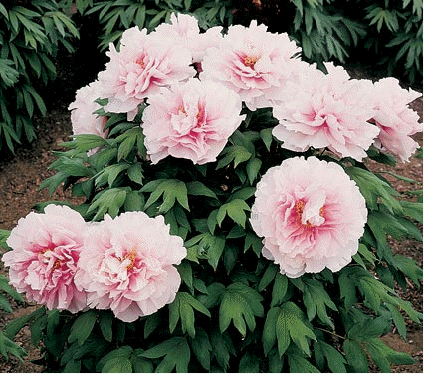

|
All
About Gardening and Gardening Q & A |
|
Bookmark
this page or add it to your favorites now! |
|
"Growing the Many Different Types of Peonies" |
|
An established peony clump can be up to three feet tall and as wide with a dozen or more large, colorful flowers. Its deep-green, glossy leaves are large and deeply divided. The foliage remains attractive in the garden all season long. Because of its clean, nicely-textured foliage and clumping growth habit, peony can be used as a small shrub border when planted close together. Peonies come in a wide range of flower colors including white, cream, yellow, pink, red, and rose. Flower forms can be single, semi-double and double. Single forms have a cluster of bright-yellow stamens in the center of the flower, providing a striking contrast to the flower petals.
|
|
When a peony is loaded with its heavy blossoms, it has a tendency to fall over, especially after a heavy rain. To prevent this, early in the season set a plant support ring over the plant just as it's beginning to grow. As the peony grows, its stems will grow through the grid inside the ring and be supported. Tall flower stems can be individually staked as well to keep the stems from falling over. Peonies grow and bloom best in full sun, although in my garden they get by with part sun and they bloom relatively well. Sometimes a peony growing in full sun will fail to bloom. When this happens, it's most likely planted too deeply, resulting in what's called a "blind peony." Peony has buds on its roots called "eyes" and should be planted so the eyes are no deeper than two inches below the surface. This includes mulch. If it's planted deeper than two inches or if mulch covers the crown too deeply the peony won't bloom. Keep mulch away from the center of the plant.
Double fernleaf peony has a look unlike most peonies. It has finely-divided foliage instead of the broad, divided leaves most peonies have. The finely-divided foliage has a feathery appearance and is quite attractive. It bears large, fully-double, deep-red flowers. It's a shorter peony, only growing 12 to 15 inches tall. It also blooms earlier than most peonies. It's in full bloom in my garden right now.
|

 Peonies
are the queens of the late spring perennial garden. They are among
the longest-lived perennials, often living 75 years or more. Once
established, they will flower for many seasons to come. In bloom in
the garden now, it's hard to top their big, bold flowers. Click on a
plant name to order it from Pernell Gerver's Online Store.
Peonies
are the queens of the late spring perennial garden. They are among
the longest-lived perennials, often living 75 years or more. Once
established, they will flower for many seasons to come. In bloom in
the garden now, it's hard to top their big, bold flowers. Click on a
plant name to order it from Pernell Gerver's Online Store.


 by
Pernell Gerver
by
Pernell Gerver Q.
I enjoy your column and look forward to it every Sunday. I have a
question about trumpet vine. I have planted several over the years in
different locations in my garden. They grow well, but never blossom.
Two years ago I planted a new one on the southwest side of my deck.
It receives afternoon sun. It has flourished, winding and curling
around the spindles, but still no blossoms. Will it ever flower?
Thank you.
Q.
I enjoy your column and look forward to it every Sunday. I have a
question about trumpet vine. I have planted several over the years in
different locations in my garden. They grow well, but never blossom.
Two years ago I planted a new one on the southwest side of my deck.
It receives afternoon sun. It has flourished, winding and curling
around the spindles, but still no blossoms. Will it ever flower?
Thank you. Pernell
Gerver, Horticultural Communication Services All rights reserved.
Pernell
Gerver, Horticultural Communication Services All rights reserved.